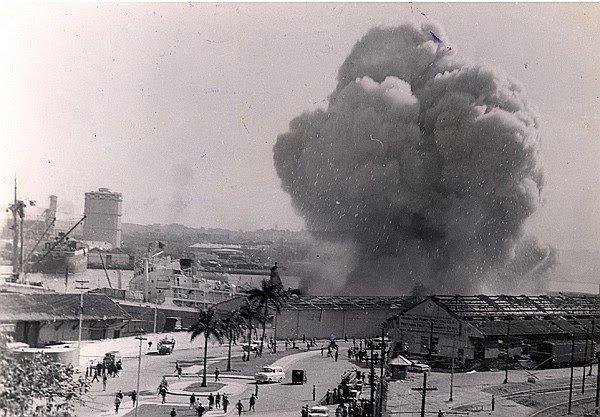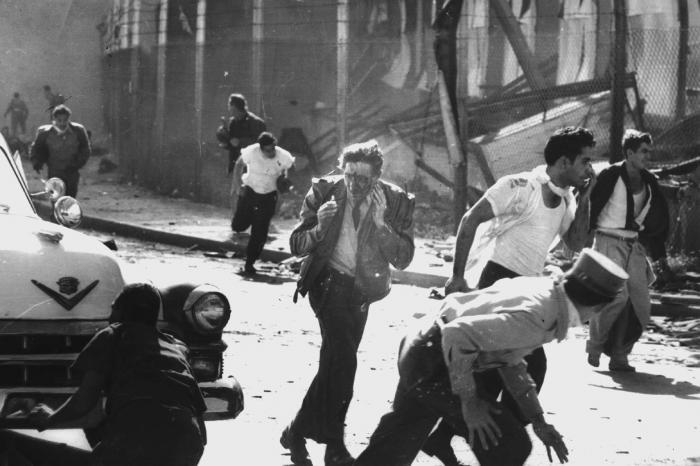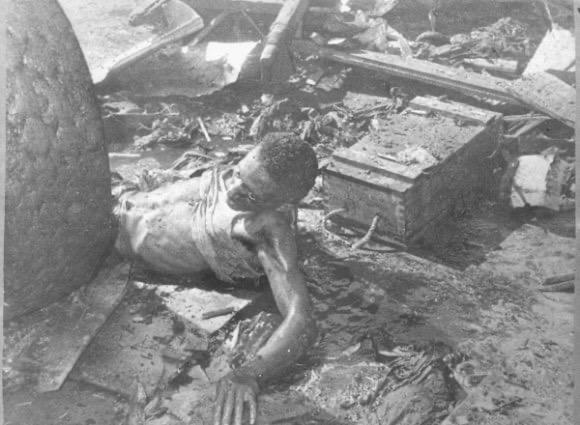
Everyone who has told anything about what happened when La Coubre was sabotaged was left with a deep wound. Juan Luis Rodriguez, for example, lost a leg; but Zenaida Capetillo, his father; and Alberto Solis, first his father, and a few days later his mother.
The scar is different in each of them, but equally deep, regardless of whether they were there when the first explosion killed crew members and dock workers who were unloading the armaments and ammunition brought by the French steamship; or at the time of the second explosion, when a sea of people had poured over the breakwater of Havana Bay, to help the wounded, to put out the fire... to recover corpses and remains.
***

Captain of Police Station 14, at 3:15 in the afternoon of that March 4, 1960, Juan Luis felt all the lighting poles in the area of Carlos III Avenue shake. His sense directed him towards Tallapiedra, he thought of the power plant, and he went there; but the crowd, the destruction and a ship in flames indicated the exact site of the disaster.
He wanted to help in many things, but his military instinct, to go first to what would prevent the tragedy from being greater, decided him to join a group that was trying to push a truck loaded with weapons and bullets into the bay, to move it away from the fire.
It was the first thing he did... and the only thing he did. The second explosion startled him. Although dazed, he felt how "an incandescent iron fractured my tibia and fibula... A mushroom of fire and black smoke rose from the ship, and immediately pieces of heads and arms began to fall."
***
When Juan Luis "ran" from Carlos III Avenue to Tallapiedra, down another street, from Zanja and Gervasio, the boy Alberto Solis, 14 years old, had also run. He did go straight to the dock; his father was a dockworker there. No matter how much he begged, they would not let him pass. Perhaps that saved him from dying with the second explosion, which occurred before his eyes.

In another house, at that same minute, Capetillo's wife asked about that explosion, and when she was told, she put her hands to her face. His daughter Zenaida said that he "was not supposed to work that day, but they went to pick him up early to speed up the unloading of the ship. Since he hadn't had lunch, he told his mother that he would get away around three o'clock, that he should have something ready for her"; but by three o'clock, four little ones had been orphaned.
The following days were the worst for the two families. Perhaps they crossed paths in the hospitals, or in the mortuary. About Capetillo, the search was fruitless. "The last time he was seen he was sitting on the bullet boxes, noting the load... We found nothing, not in the bay or anywhere."
Alberto persisted for seven days in the search for Alonso, his father. What an indescribable trauma for a child to go through and review the drawers of a morgue, full of corpses, of pieces of them, unrecognizable! He had looked more than ten times in drawer 85, when, after a week, a companion of his father, a survivor, told him to stop there.
"He had lost part of his face, a leg, he was all burned and he had several bullet impacts on his body from the armament the ship was carrying (...) Indeed, when they transferred him from there to the coffin, underneath were his burnt clothes, but some of them we could identify."
Shortly thereafter, the boy Alberto went from being Esther's older brother to being her father. Maria del Carmen, his mother, became ill after the tragedy, and passed away.
***
With the sabotage to the steamship La Coubre there were more than a hundred dead and missing, but the number of wounded is still unknown: it was reproduced, constantly, in the pain of the families. There were many Juan Luis, and Zenaidas, and children like Alberto, who walked desperately through hospitals and morgues.
This is how nurse Gloria Azoy told it, several years later: "...I picked up some remains, just this part of the eyes, impressive, as if they were alive, and I put them on a dressing. Later a child approached me, trying to find information about his lost father. I looked at him, and immediately understood who he was looking for. 'Those are my father's eyes,' he told me."
However, the U.S. Government likes to say that Cuba sponsors terrorism, and for long years it says it does, and then it says it doesn't, for a few days, and again it says it does. Are we the terrorists?
Source: Granma newspaper archive















